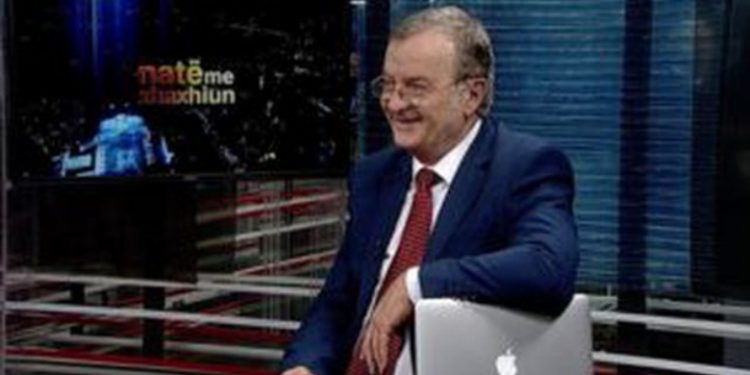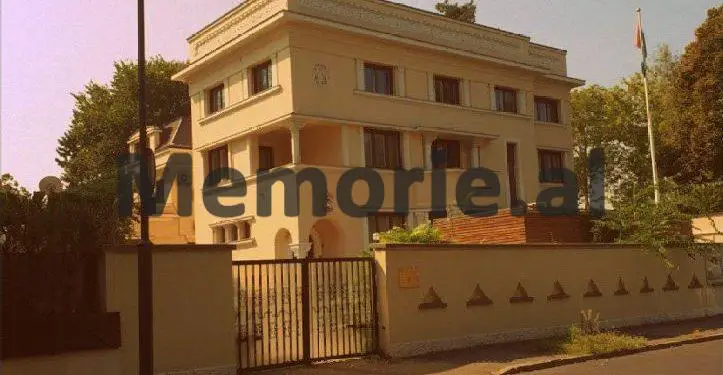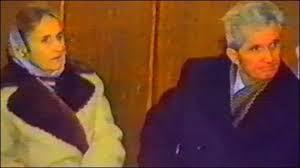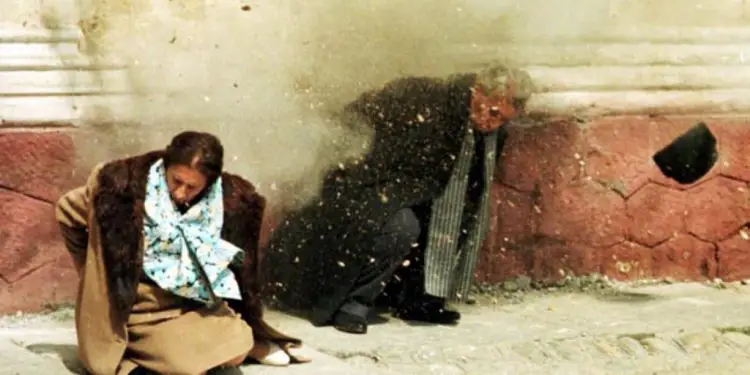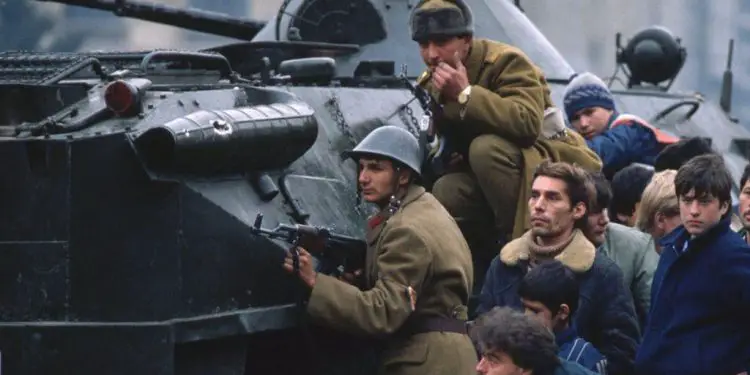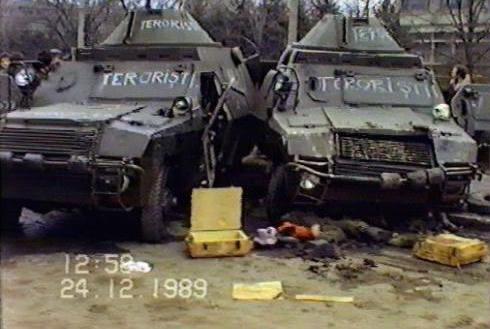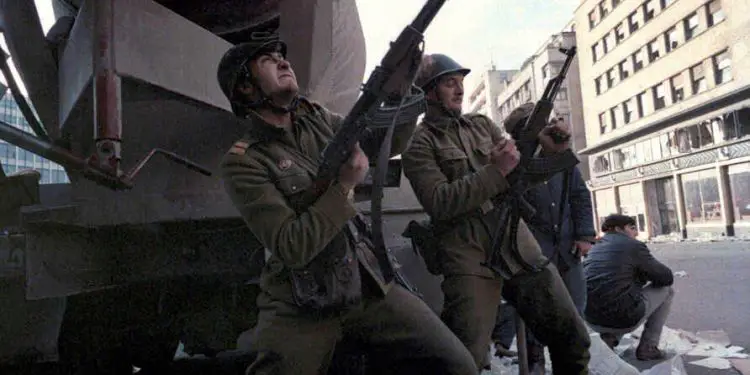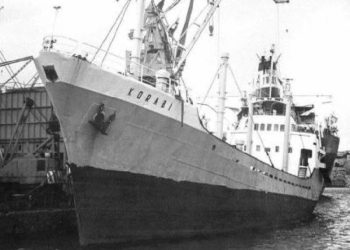Dashnor Kaloçi
Memorie.al publishes the unknown story of the mass protests of the Romanian people at the end of December 1989, which led to the overthrow of the communist leader, Nicolae Ceausescu, who had ruled the country since 1965, after the death of George Dezhi. Rare testimonies of the well-known journalist and moderator, Rezar Xhaxhiu, who from 1987 to March 1991, served as Press and Culture Attaché at that embassy, which exclusively tells Memorie.al, making public for the first time, how the staff of that embassy, led by Ambassador Pirro Vito, experienced the sensational events of the mass protests of the Romanian people, where for several days in a row, the staff of that diplomatic headquarters was forced to take up arms and take up positions in different parts of that building? What messages did they receive from official Tirana through the Ministry of Foreign Affairs and how did they get through the most difficult moment, when the Albanian embassy was surrounded by Army tanks commanded by General Vasile Milea who had joined the protesters, after the news broke that the dictator Romanian, Ceausescu, with his wife, Helena, were sheltered in the basements and tunnels of that embassy?!
“I remember that all the relatives of the staff of our embassy, had gathered together and stood in the basements of that building, under a real uncertainty and panic, of what could happen in the following hours! Meanwhile, that part of our families who had taken refuge outside the embassy building, experienced twice as much and more fearfully, the battle of several days on the streets of Bucharest. I remember my friend, whom I found every time I came back from the embassy, terrified and stiffened by panic, fear, and insecurity. At the time, we had a 6-month-old daughter, and I often found them both under the window sill, to escape the bullets coming from everywhere. It was fired from all sides, and those who were most treacherous were the Securitates USLA (Special Anti-Terror Unit) snipers, which were placed on the terraces of palaces, and official buildings. But in many cases, it was not known who was shooting?! It was Christmas Eve, December 25, 1989, when we learned of Ceausescu’s arrest. He and his wife, Elena, were stopped by an army checkpoint near Targovishte. “During this moment, the presidential couple Ceausescu, was heading to an airport, trying to escape from Romania, and seek political asylum in a country friendly to Romania.”
This is how the well-known journalist and moderator Rezar Xhaxhiu remembers, among other things, the sensational events that took place three decades ago in Romania, where at the end of December 1989, due to the mass protests of the Romanian people in the capital of the country. , Bucharest, communist leader Nicolae Ceausescu and his wife, Helena, were detained at a checkpoint on the outskirts of a small town on the border with Hungary in an attempt to flee the country. executed after a ‘flash’ trial!
Located in the ranks of the diplomatic service (as Attaché of the Press and Culture), near the Albanian Embassy in Bucharest since the beginning of 1987, as an eyewitness, Xhaxhiu, had the opportunity to follow closely the protests of the Romanian people, which led to the overthrow of dictator Nicolae Ceausescu, who had ruled that great Balkan country since 1965, following the death of George Dej.
How was Rezar Xhahiu selected to serve in the ranks of Albanian diplomacy, who were the other colleagues he worked with from 1987 until March ’91 when he returned to his homeland, how did the work at that diplomatic headquarters work? and how the staff of that embassy, led by Ambassador Pirro Vito, experienced the sensational events of the mass protests of the Romanian people in late December 1989, where for several days, the staff of that diplomatic headquarters was forced to arm themselves and took positions in different parts of that building?
What messages did they receive from official Tirana through the Ministry of Foreign Affairs and how did they get through the most difficult moment when the Albanian embassy was surrounded by Army tanks commanded by General Vasile Milea, after the news broke that Romanian dictator Ceausescu and his wife his, Helena, were sheltered in the basements and tunnels of that embassy?!
Regarding these and other unknown events that took place in the Albanian embassy accredited in Bucharest in the period, 1987-1991, Rezar Xhaxhiu tells us for the first time, in this exclusive interview for Memorie.al, which will continue in some consecutive numbers.
Follows from the previous number
Mr. Xhaxhiu, how did you act?
I told him: ‘we are a diplomatic corps and you have no right to stop us, let alone control us’!
How did they respond to you?
It was difficult to get along with them, as they had no idea of the diplomatic corps, the immunity we enjoyed and the rights and inviolability that diplomats have. But they insisted that we get off and they checked our car, who knows what suspicions.
Did you accept, so did you submit to their control?
Thankfully in those moments, there came an older person, who must have had some kind of influence on the boys, who then withdrew, asking us, “Whose embassy are you in?”, And after learning that we were from Albania, one of them added: “Get ready, very soon, it will be your turn”. When I think about it…, was it a kind of prophecy, said by a Romanian boy, through the streets of Bucharest…?! I remembered this guy two years later, when the events in Tirana started.
As far as we know, even the Albanian embassy in Bucharest where you were, had problems with the protests that took place at that time?
Yes, it is true, it must have been December 22, if I am not mistaken, when one afternoon we saw that two or three tanks were stationed around the embassy! We were surprised, but we were also worried at the same time, thinking what did the army tanks want, in front of our embassy building?! Then we saw the presence of soldiers, placed in the distance, as well as other movements that surprised us, but also alerted us, why not, and moments of fear and anxiety!
What had happened, then, why had those tanks come there?!
They had arrived after a silent siege by armed military troops had begun at an embassy headquarters in central Bucharest. Through the communications that our ambassador, Comrade Pirro Vito, had with representatives of the Ministry of Foreign Affairs in Tirana, he learned that this siege had to do with the fact that: the Romanians thought that Ceausescu and his wife, Elena, had taken refuge in basements of the Albanian embassy!
In your opinion, who opened the false news that the presidential couple was sheltered in the basements or the tunnel of the Albanian embassy?
It is, in fact, an enigma, how such an absurd conjecture arose. But we have to keep in mind something, that in those chaotic days, tension, clashes, fighting, news and counter-news, fake news, gossip in the form of news, and news in the form of gossip, everything that is said takes place, and is taken for granted. Perhaps in this context, there was also the widespread news that Ceausescu was sheltered inside our embassy. I do not believe in the fact of a provocation by the Romanians, because in that period, no one had the mind to provoke a state, or an embassy, when no one knew what would happen the next day.
Was the life of the employees of the Albanian Embassy in Bucharest in serious danger at any point, from those protests?
In those tense days and hours, all the embassy staff gathered inside it and Ambassador Pirro Vito, after a meeting on foot, told us, among other things: ‘now it is our turn to defend this piece of homeland that is here in Romania’. They were electrifying moments, fear, panic, insecurity, tension, which were clearly seen in all of us. No one knew what might happen an hour later, or for hours, until dawn. At one point, we were even given guns.
What weapons…?!
We must keep in mind that all our diplomatic missions anywhere in the world where they were accredited, or part of them, had a mini-arsenal of weapons, which were kept in a metal box, while ours in Bucharest, could to have decades without opening, until it had rusted! I was given a “Carbine” rifle and I was assigned a place of defense, which was a turret. So, a window between the first and second floor of the headquarters.
What about the other members of the staff who were provided with weapons?
Of course, yes. Our late colleague, Marco Bello, took on the task of guarding the first floor armed. The weapon I took seemed to have been unseen for years, ‘sunlight’, as it showed signs of rust and spiders. Based on this, I told the ambassador, ‘what can I do with this rusty gun’, also based on the knowledge I had about guns, thanks to the snowflakes we made endlessly, throughout the school (laughs).
How did he respond?
He said to me, “Hold fast, for it gives you security and confidence.” I could not understand what security Ambassador Vito për was talking about, but anyway, I obeyed the order, praying to God that everything that was happening was not true! All this state of readiness lasted for hours, until the moment when the ambassador had a telephone conversation.
With whom did Ambassador Pirro Vito communicate, and was this situation later tense?
I do not remember now whether the conversation he had was a telephone conversation or a meeting at the Romanian Ministry of Foreign Affairs, where he forcefully asked the Romanian authorities to urgently remove the presence of military troops from the siege of the embassy, calling it this as an idiotic, and meaningless provocation! He gave a full guarantee that the news and noise about Ceausescu’s accommodation at the Albanian embassy was, if not a rumor, a banal provocation. Maybe after this conversation, or maybe that the Romanians received other information, or maybe that Ceausescu was arrested the next day, the military troops finally withdrew from the siege of our embassy territory.
After this case, did you have any other moment when the lives of the embassy employees were put in danger?
No one knew how much the lives of the embassy staff were being endangered in those moments. What we knew was how we could withstand this “attack” with tanks and soldiers, on a diplomatic headquarters. For this reason, measures were taken and kept at all times in relation to the Ministry of Foreign Affairs in Tirana, which instructed us on what we should do in each further step. I remember that one of the many orders we received was the destruction of the embassy documentation over the years, so that the archive would not fall into the hands of Romanian demonstrators, in case they would enter the premises of our building. But as long as the fighting in the streets of Bucharest continued, even if it was later sporadic, our lives were in constant danger.
How was the elimination of the archive of the Albanian embassy in Romania done?
I still remember the scene when we put the files and boxes of documents in the embassy boiler, to burn them, that is, a whole memory of an embassy, which had been opened since the Second World War! It was a painful and exciting process at the same time, just like in Hollywood movies, so surreal I can say.
What about your family, and other family members of the embassy staff, what happened in the meantime?
Meanwhile, I remember that all the family members of our staff, had gathered together and stood in the basements of the embassy, under a real uncertainty and panic, of what might happen in the following hours! Meanwhile, that part of our families who had taken refuge outside the embassy building, experienced twice as much and more fearfully, the battle of several days on the streets of Bucharest.
How did your family react to this dire situation of bloody fighting?
I remember my friend, whom I found every time I came back from the embassy, terrified and stiffened by panic, fear, and insecurity. At the time, we had a 6-month-old daughter, and I often found them both under the window sill, to escape the bullets coming from everywhere. It was fired from all sides, and those who were most treacherous were the Securitates USLA (Special Anti-Terror Unit) snipers, which were placed on the terraces of palaces, and official buildings. But in many cases, it was not known who was shooting?!
How do you remember the moment of arrest and isolation of Ceausescu and his wife Elena, by the Army forces?
It was Christmas Eve, December 25, 1989, when we learned of Ceausescu’s arrest. He and his wife, Elena, were stopped by an army checkpoint near Targovishte. During this moment, the presidential couple Ceausescu, was heading to an airport, trying to escape from Romania, and seek political asylum in a country friendly to Romania.
Where did you learn this news?
We learned the news and saw it on Romania’s state TV, in the evening news edition. It was a dramatic moment, to see how a former communist leader, of a country of 25 million people, came out that way, through the doors of a blind man, and behind him, the most hated face for Romanians, his wife, Elena Ceausescu.
How do you remember the moment of the trial and the death sentence of the Ceausescu couple, so how did you convey to your embassy colleagues what happened to them?
The trial of the dictator was a comedy in itself, a farce, for which there were many reservations and controversies, in that period. It took place if I am not mistaken, either in a school, or on the premises of a military ward, but in a classroom of this ward, as everything looked like a classroom. A military tribunal, set up quickly, charges of “genocide, and treason”, as well as other typical charges, of a speedy military trial, or “field trial”, as it was called at the time!
Were there any debates and controversy, on the part of Romanian public opinion, over this speedy trial by the Ceausescu couple?
For this quick trial, there was a great debate during those days, but also afterwards. It was speculated why this trial should have taken place, why so quickly, why that sudden execution, etc., etc.?! If I am not mistaken, the Romanian officials said that: they were forced to carry out such a flash execution, a flash trial, and a similar decision, for the fact that only in this way they could stop, or at least mitigate it all. the tumult of tension, and the armed clash that was taking place day after day ‘. And in fact, it happened. After their execution, the resistance of the supporters of the regime, mainly the few fanatics, and the special units of the Securitate’s, faded, eventually fading, in the following days.
Did you have any official reaction from Tirana after the shooting of the Ceausescu couple, and if so who was he?
Throughout this period of time that these events took place, I remember that our Ministry of Foreign Affairs was very active in terms of the instructions it sent every hour. The telegrams and letters, which arrived from the Ministry of Foreign Affairs, reminded us to ‘be careful, and to be dignified in our attitudes, to show integrity and with our heads held high, in front of foreign diplomats’, etc. I remember specifically, one of the telegrams bearing the signature, if I am not mistaken, of Reiz Malile, or of Sokrat Plaka, who said: sovereign countries”! There was a lot of drama in this telegram, which was read to us, as a collective to give us, “strength and courage”.
How did you experience there in Romania, the moment of the opening of embassies in our country, 6 months after the overthrow of Ceausescu?
The opening of the embassies, in July 1990, was totally a shocking moment for us. News of the opening of embassies came to us sporadically. From the Ministry of Foreign Affairs there was at first total silence, but then, some dry telegrams flooded in, with a typical terminology of the time.
What was communicated to you in these official telegrams?
Those telegrams said, “A group of dissatisfied, citizens who do not represent the Albanian society”. ” The most detailed news, we transmitted through foreign agencies, or radio stations, especially from neighboring ones.
What was happening at our embassy in Bucharest at that time?
In our embassy, there was an uncertainty that doubled, even as a result of accurate information, about what was happening in the homeland. From our family members, it is not that we received more information, because in that period the opportunity to communicate with the families we had in Albania was not so easy. But even when this was done, on the other side of the phone came some responsive words, of which more, you were confused, than you were getting accurate information, of what was happening! From our press, which arrived every day at the embassy two days late, mainly “Zeri i Popullit”, “Bashkimi”, “Zeri i Rinisë”, and any magazine of the time, you did not learn anything. Meanwhile, we were more and more under the pressure of questions and interest of fellow diplomats, during meetings with them, waiting for cocktails. Our answers, however, were evasive, ambiguous, and often contradictory.
The same period of the outbreak of demonstrations in December 1990, which demanded political pluralism. How was this received by you and your colleagues at the embassy?
The events of December 1990 were another shock to our embassy in Romania in general, and its staff in particular. This is also due to the fact that when you are away from home, what happens in the homeland, comes in the form of a multiplication of an enigma, wrapped in lack of information, or with the presence of contradictory information, sometimes official and sometimes in the form of rumor. Sometimes in one case of fake news and sometimes in the other case of a news story with different loads.
What were the directives of the Ministry of Foreign Affairs, which were transmitted to you, regarding those events?
In general, the Ministry of Foreign Affairs telegrams that came to us about the events of December were dry, and often reminded us to ‘be careful in our conversations with our diplomatic colleagues, to be prudent, and not to we provided more information than what was served to us from the center ‘, etc. The common content of the telegrams was approximately the same…! It told us: “An attempt to overthrow the dictatorship of the proletariat by force. Stay at the right professional height of duty, and representation of our state, beware of provocations that may come to you, be prudent in the conversations you have with the diplomatic corps, etc., etc. We were numb and moving inside an information darkness, which we tried to break through with different tools and ways.
Seeing with your own eyes what happened in Romania, were you afraid of repeating any Romanian scenario in the communist Albania of that time?
I do not know if we were afraid of any repetition of the Romanian scenario, but of an uncertainty, how events would unfold in Albania. But anything was possible. Due to the lack of information, we could not make any more detailed analysis of how events would be perceived in our country. Either to make some accurate predictions, or to draw parallels with what we had experienced a year ago.
How do you remember the moment of leaving and coming to Albania, given that in 1991, practically the communist regime in our country, had fallen?
I served as Secretary (Attaché) for Press and Culture at the embassy until the beginning of March 1991, when I returned to Rinas. In the same Rinas I had left for Bucharest, four years ago. But this time much different.
What was your first impact when you returned to Albania?
My first impression, when I returned to the country, was that at Rinas airport, from two or three planes that departed per week, during the ’80s, I saw the same planes, from which the first traders with sports bags got off., filled with scrap metal and clothing, which were purchased in the markets of Romania, Hungary, or Bulgaria. There I noticed the first Albanian refugees boarding the stairs of planes, confused and scared, accompanied, with police, with and without uniform. It was a completely different Albania, what I touched on that March of 1991.
And today, 31 years after the outbreak of revolts and bloody fighting in Romania, how do you comment on those events through the eyes of an analyst and journalist?
The events in Romania were the process of a chain that was taking place in the countries of Eastern and Central Europe. They were a phenomenon of ‘domino stones’, but they had their specificity in relation to many other Eastern countries. Even today, there are many mysteries, about many events of those days. What was the role of the Soviet embassy in Bucharest? Why did the overthrow in this country have to be done by force? And how is it that at the head of the new post-communist Romania, former bureaucrats of Ceausescu’s Communist Party, headed by Ion Iliescu, were placed in key positions? How is it possible that in the period of Romanian transition, which had just begun, government positions were held, former communists, some of whom were educated in Soviet universities?! What about the role of the army, which united with the people, and the role of the secret police (Securitates) that remained loyal to the end to the presidential couple, Ceausescu?! What about the suicide of Vasile Milea, who refused to let the Army shoot at the people?! As in any revolutionary overthrow, or such events, even in the developments of those events in Romania, many details will still remain undiscovered and shrouded in mystery!/Memorie.al





